Ivy – Realistic (1995, Seed)
 I happened to see Ivy opening for They Might Be Giants on their John Henry tour in upstate NY in '95. My memory is still vivid of entering the concert hall (gymnasium) as Ivy were in the middle of playing “15 Seconds.” I was so struck by the perfect, slightly melancholy pop melodies, and the scintillating guitar strum and vocal pattern that fades out the song, I was mesmerized. I don't recall much of the rest of their set, except that it was all very catchy and I knew I had to get their CD ASAP. I also bought a bag of TMBG promotional coffee that night, and indeed it was the very best TMBG concert I had the pleasure of attending (out of a total of four in the '90s). But Ivy still holds a place in my permanent collection of '90s alternative rock greats, and their debut album “Realistic” is just about as good as it gets. Everything seems just right in these songs, the production is great, the guitar effects have a perfect tone (love the wah pedal), and Dominique Durrand's vocals are sweet and soothing. The songs are short and catchy, and the album has a great summer vibe. Top notch alternative pop music. Their next album “Apartment Life” was excellent as well, and featured a vocal appearance by James Iha from Smashing Pumpkins, which helped increase their indie credibility a bit. Check them both out! More recently they did a cool dance-y cover of The Cure's “Let's Go To Bed.” This is one of those bands I really wish I had bought on vinyl when I had the chance...
I happened to see Ivy opening for They Might Be Giants on their John Henry tour in upstate NY in '95. My memory is still vivid of entering the concert hall (gymnasium) as Ivy were in the middle of playing “15 Seconds.” I was so struck by the perfect, slightly melancholy pop melodies, and the scintillating guitar strum and vocal pattern that fades out the song, I was mesmerized. I don't recall much of the rest of their set, except that it was all very catchy and I knew I had to get their CD ASAP. I also bought a bag of TMBG promotional coffee that night, and indeed it was the very best TMBG concert I had the pleasure of attending (out of a total of four in the '90s). But Ivy still holds a place in my permanent collection of '90s alternative rock greats, and their debut album “Realistic” is just about as good as it gets. Everything seems just right in these songs, the production is great, the guitar effects have a perfect tone (love the wah pedal), and Dominique Durrand's vocals are sweet and soothing. The songs are short and catchy, and the album has a great summer vibe. Top notch alternative pop music. Their next album “Apartment Life” was excellent as well, and featured a vocal appearance by James Iha from Smashing Pumpkins, which helped increase their indie credibility a bit. Check them both out! More recently they did a cool dance-y cover of The Cure's “Let's Go To Bed.” This is one of those bands I really wish I had bought on vinyl when I had the chance...











